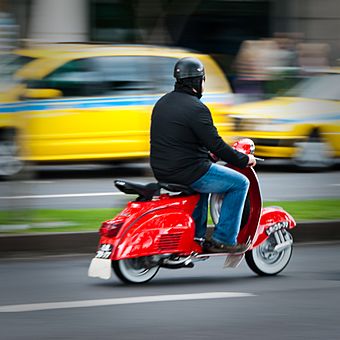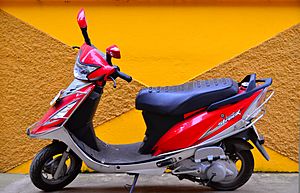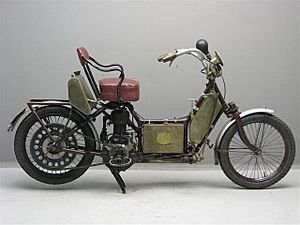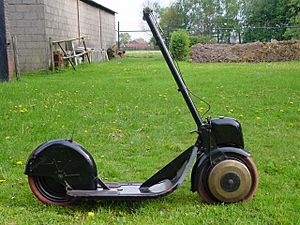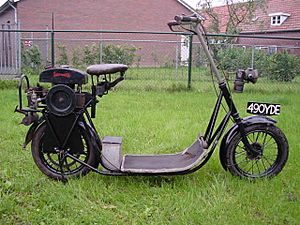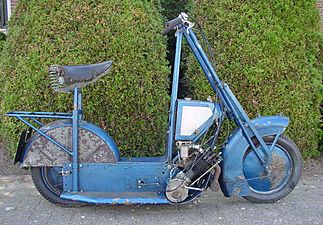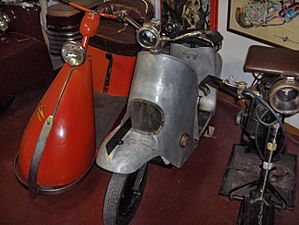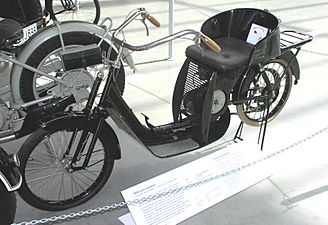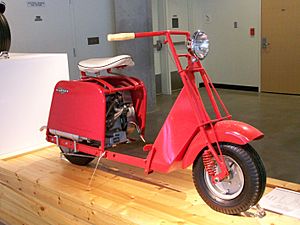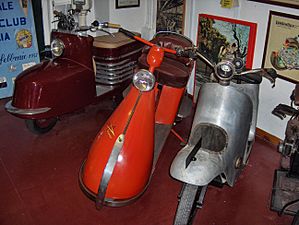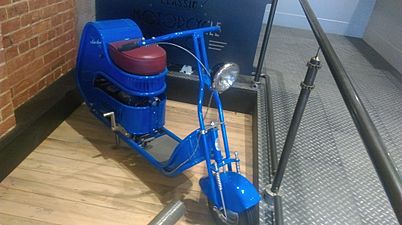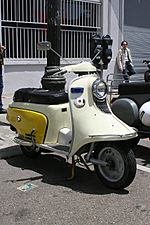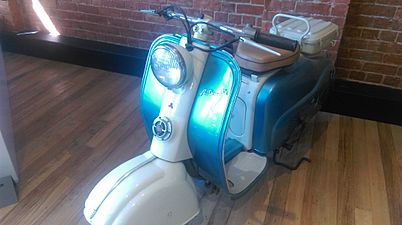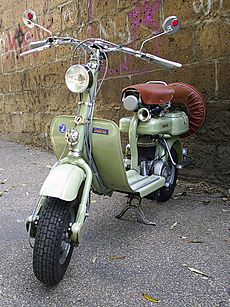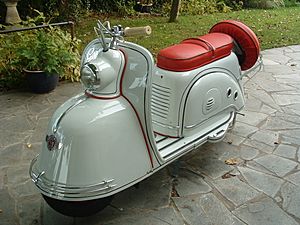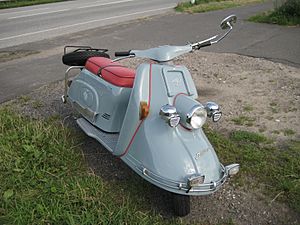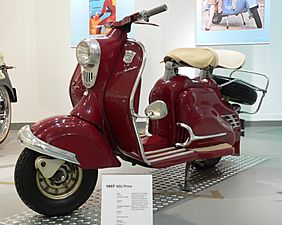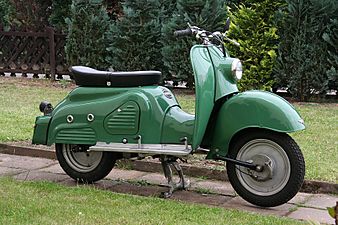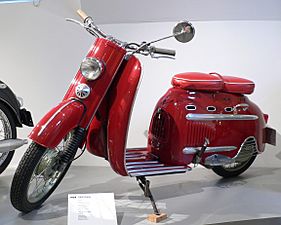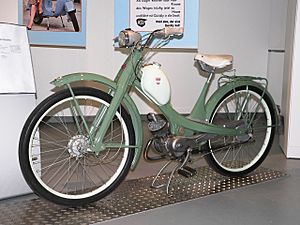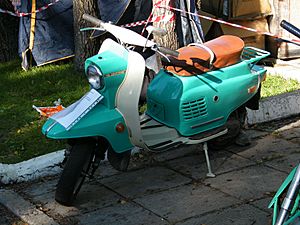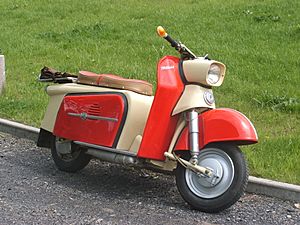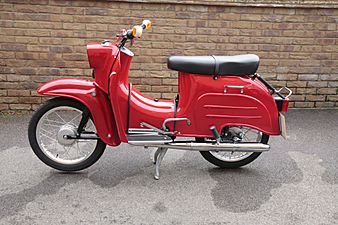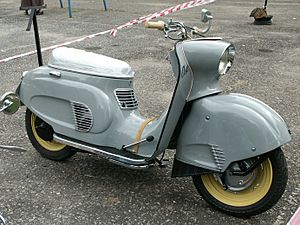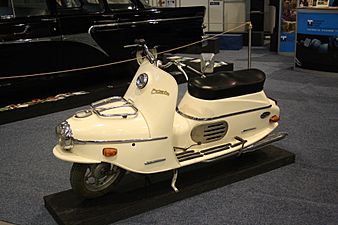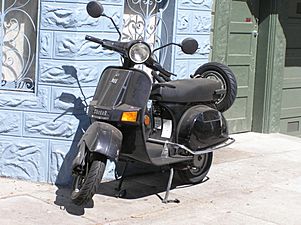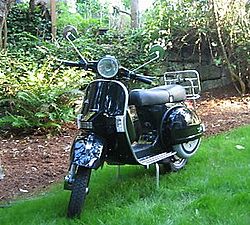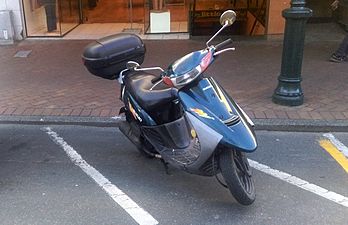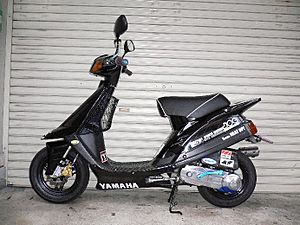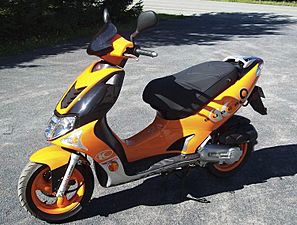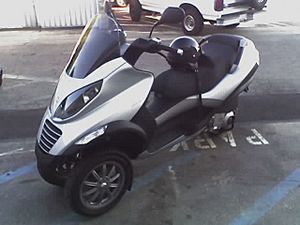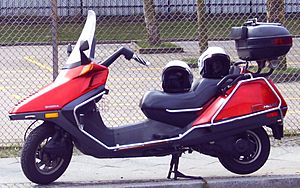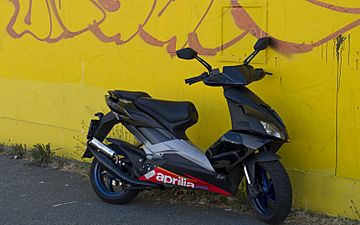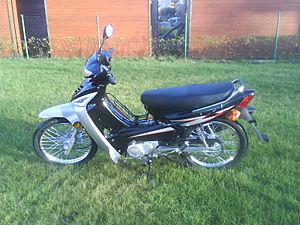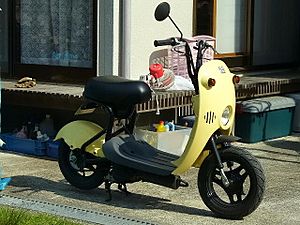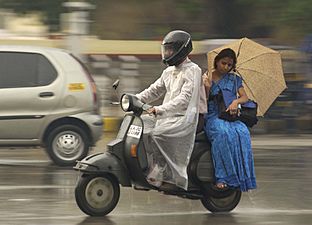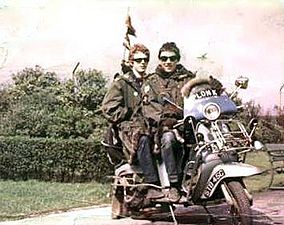Scooter (motorcycle) facts for kids
A scooter (also called a motor scooter) is a type of motorcycle. It has a special frame that lets you step through to sit down, a comfy seat, and a flat place for your feet. Scooters are popular because they are easy to ride and save on gas! People have been making scooters since at least 1914.
The Vespa and Lambretta scooters from Italy became super popular all over the world after World War II. These scooters were made to be a cheap way for people to get around. They usually had small engines (from 50 to 150 cubic centimeters). Today, you can also find "maxi-scooters" with bigger engines (from 200 to 850 cubic centimeters) for longer rides.
Scooters are a favorite way to travel because they are often cheaper to buy, simpler to drive, and easier to park than cars. In many places, it's also easier and less expensive to get a license and insurance for a scooter than for a car. Sometimes, people use "motor scooter" to make sure you don't confuse it with a kick scooter (like a skateboard with handlebars). But then, it can get mixed up with an electric scooter!
Contents
What Makes a Scooter Special?
The dictionary says a motor scooter is like a kick scooter but with a seat, a floorboard for your feet, and small wheels. The US Department of Transportation says a scooter is a motorcycle with a platform for your feet or built-in footrests, and a step-through design.
Design and Features
Classic scooters have a step-through frame and a flat floorboard for your feet. This design works because most scooter engines and drive systems are either attached to the back wheel or hidden under the seat. Unlike regular motorcycles where the engine is fixed to the frame, most modern scooters have the engine move with the back wheel. Older scooters and some new "retro" ones have the engine fixed to the axle.
Most modern scooters (from the late 1980s) use an automatic transmission called a continuously variable transmission (CVT). This means you don't have to shift gears! Older scooters used a manual transmission where you shifted gears with a control on the left handlebar.
Scooters usually have bodywork that covers most of their mechanical parts, including a shield in front to protect your legs. They often have built-in storage space, like under the seat or in the front leg shield. Scooters come with different engine sizes, from small 50 cubic centimeter single-cylinder engines to large 850 cubic centimeter twin-cylinder models.
Traditionally, scooter wheels are smaller than motorcycle wheels. They are often made of metal and are easy to bolt on, sometimes even interchangeable between the front and back. Some scooters even carry a spare wheel! Many newer scooters use regular front forks where the front wheel axle is held at both ends.
Scooter Rules and Laws
Some places don't see a difference between scooters and motorcycles. But in other places, smaller scooters (usually 50 cubic centimeters or less) are grouped with mopeds. This often means they have fewer rules. For example, in many areas, you might be able to drive a 50cc scooter with a regular car driver's license, or even without a license if you're an adult (like in Denmark, with insurance). They might also have lower taxes and easier safety checks.
Rules in the United States
In the United States, the National Highway Traffic Safety Administration (NHTSA) suggests calling all these vehicles "motorcycles" for legal reasons. Even though they don't officially define "motor scooter," they still give detailed instructions on how to bring a small motor scooter into the country.
California's Scooter Laws
As of 2020, California has specific rules for vehicles with 2 or 3 wheels:
- Motorcycle: A 2- or 3-wheeled gas vehicle weighing under 1,500 pounds with an engine of 150cc or more. You need a special M1 license, registration, insurance, and a motorcycle license plate. You can ride on any public road, including highways, and carry one passenger. Helmets are a must.
- Motor-driven cycle: A 2-wheeled gas vehicle with an engine of 149cc or less that can go faster than 30 mph. It has similar rules to a motorcycle (license, registration, insurance, helmet) but can't go on highways. These are often called "scooters."
- Moped: A 2- or 3-wheeled vehicle with an automatic transmission that can't go faster than 30 mph. It can have a gas engine under 50cc with pedals (like a bicycle) or be electric (under 4 horsepower). No registration or insurance is needed for the moped itself, but the driver needs an M1 or M2 license and personal car insurance. It needs a special moped license plate. You can have one passenger if there's a proper seat and footrests.
- Motorized scooter: A 2-wheeled vehicle that can't go faster than 15 mph and has a floorboard to stand on. No license plate or insurance is needed for the scooter. You need a regular Class C driver's license and a bicycle helmet. You can't have passengers. You can ride on bike paths but not sidewalks. If there's a bike lane, you must use it. To turn left, you have to get off and cross like a pedestrian.
- Electric bicycle: California has three types of electric bikes. They have pedals and an electric motor that helps you ride. They don't need insurance, a license, or registration because they aren't considered "motor vehicles."
Scooter Emissions
Studies have looked at how much pollution scooters and mopeds create. Older two-stroke 50cc mopeds, even with special filters, can release much more pollution (like hydrocarbons and tiny particles) than cars. Four-stroke mopeds are better but still release more than cars.
Because of air pollution, some cities like Shanghai have banned gasoline scooters and mopeds. Instead, they allow electric scooters or those that run on LPG (a type of gas).
The History of Scooters
Early Designs (Before 1915)
Scooter-like features started appearing in motorcycle designs around the 1900s. In 1894, a German company called Hildebrand & Wolfmüller made the first motorcycle you could buy. It had a step-through frame and its engine was low on the frame. It was the first mass-produced two-wheeled vehicle powered mainly by its engine.
In France, the Auto-Fauteuil came out in 1902. This was basically a step-through motorcycle with a comfortable armchair instead of a regular seat! They kept making these until 1922.
- Early scooter-like vehicles
First Scooters (1915–1930)
The Motoped started being made in 1915, and many believe it was the first motor scooter. The Autoped followed that same year. You pushed the handlebars forward to make it go and pulled them back to brake. Autopeds were made in New York until 1921, and also in Germany by Krupp after World War I.
More scooter makers appeared after World War I. British scooters like the ABC Skootamota, the Kenilworth, and the Reynolds Runabout came out in 1919. The Gloucestershire Aircraft Company made its Unibus in 1920. The Skootamota was known for being practical and popular. The Reynolds Runabout had advanced features like front suspension and a two-speed gearbox. The Unibus had full bodywork, similar to later scooters.
However, many early scooters had weak frames and were unstable. The better ones, like the Reynolds Runabout and Unibus, were too expensive. So, this first generation of scooters mostly ended by the mid-1920s.
- First generation scooters, 1915–1930
Second Generation (1936–1968)
In 1936, E. Foster Salsbury and Austin Elmore started making the Salsbury Motor Glide in California. This scooter had a seat over an enclosed engine. In 1938, Salsbury made a more powerful scooter with a continuously variable transmission (CVT), which was a first for scooters! It was so successful that it set the standard for many scooters that came after it.
The Cushman Company also made motor scooters from 1936 to 1965. Cushman and Salsbury were rivals, both saying their scooters saved a lot of gas. Cushman even made the "Cushman Airborne" scooter, designed to be dropped by parachute for Army troops during World War II.
Salsbury stopped making scooters in 1948, but Cushman continued until 1965.
Harley-Davidson also made a small number of their 165cc Topper scooters from 1960 to 1965. It had a fiberglass body, a CVT, and a pull-cord to start it.
- Second generation scooters, United States, 1936–1965
-
A typical Cushman scooter, sold by Sears as an Allstate brand.
Early Post-War Japan
After World War II, Japanese aircraft makers were not allowed to build planes. So, they looked for other products. Fuji Sangyo, part of the old Nakajima Aircraft Company, started making the Fuji Rabbit S-1 scooter in 1946. It was inspired by Powell scooters used by American soldiers and even used a tailwheel from a Nakajima bomber as its front wheel! Later that year, Mitsubishi introduced its Silver Pigeon scooter, inspired by a Salsbury Motor Glide brought to Japan.
Both the Mitsubishi Silver Pigeon and Fuji Rabbit were made until the 1960s. Some Fuji Rabbit models were very advanced, with automatic transmissions, electric starters, and air suspension.
- Second generation scooters, Japan, 1946–1968
Third Generation (1946–1964) and Beyond
Italy: Vespa and Lambretta
After World War II, the Piaggio Vespa became the most famous scooter, and it still is today! Patented in 1946, it used aircraft design ideas. Its 98cc engine was placed near the back wheel, and the gear shift was on the handlebars, making it easier to ride. The body design protected the rider from wind and dirt. The smaller wheels and shorter design made it easy to steer in busy streets. The name "Vespa" means "wasp" in Italian, because it looked like a wasp!
A few months after the Vespa, in 1947, Innocenti introduced the Lambretta, starting a friendly competition with Vespa. The Lambretta was named after the area in Milan where the factory was. It sold 9,000 units in its first year! It was very fuel-efficient, which was important when gas was limited.
Other Italian companies like Italjet and Iso also made scooters in the 1950s and 1960s.
Germany
Germany's aircraft industry was also shut down after World War II. Heinkel started making bicycles and mopeds. Messerschmitt made sewing machines and car parts. Messerschmitt even built Vespa scooters under license from 1954 to 1964. Heinkel designed its own scooters, like the Heinkel Tourist, a large touring scooter from the 1960s. It had great weather protection and could go 70 mph (113 km/h) even with its 175cc engine. Heinkel scooters were known for being very reliable.
Glas, a company that made farm machines, built the Goggo scooter from 1951 to 1955. They stopped making scooters to focus on their small Goggomobil cars.
Many German motorcycle companies also made scooters. NSU made Lambrettas under license and then developed their own Prima scooter. Zündapp made the popular Bella scooter in the 1950s and 1960s, which was known for being reliable and well-made. Maico built the large Maicoletta scooter, which could go 70 mph (113 km/h), as fast as many 250cc motorcycles of that time! Other German scooters included the DKW Hobby and the Dürkopp Diana.
- Classic German scooters
United Kingdom
In the UK, Douglas made Vespa scooters under license. BSA and Triumph also made scooters like the BSA Dandy 70 and the Triumph Tigress. The Tigress could go 70 mph (113 km/h) with its 250cc engine.
More recently, in the 2000s, the Scomadi scooter was designed and made in the UK. These scooters looked like classic Lambrettas. Production later moved to Thailand.
Eastern Bloc
In countries like the Soviet Union and East Germany, scooters also became popular in the late 1950s. The Soviet Union started making copies of the Vespa and Glas Goggo scooters, called Vyatka and Tula T-200. These were made in large numbers until the 1980s. In East Germany, IWL made their own scooters, like the SR 59 Berlin. Poland had the WFM Osa, and Czechoslovakia had the unique Čezeta scooter.
- Eastern Bloc scooters
India
API was the first scooter maker in India, with a Lambretta model in the 1950s. Bajaj Auto made its own scooters from 1972 to 2009, including the Chetak and Legend, which were based on the Italian Vespa Sprint.
Another Vespa partner in India was LML Motors. They made P-Series scooters for the Indian market. LML still makes and exports a version of the P-Series called the Stella in the U.S.
Scooters are very popular in India, using about 70% of the country's gasoline. Electric scooters are becoming more popular because they are much cheaper to run than gasoline versions.
- Indian scooters
East Asia
Since the 1980s, Japan, China, and Taiwan have become leaders in making plastic-bodied scooters, often with "twist-and-go" automatic transmissions. The Honda Spree/Nifty Fifty was an early popular model. Japanese scooters were very popular in the USA in the 1980s, with ads featuring stars like Michael Jackson.
Both 2-stroke and 4-stroke plastic-bodied scooters have been mass-produced in East Asia. Electric scooters are also becoming very common in China.
- East Asian plastic-bodied scooters
-
The Suzuki SJ50QT made by the Chinese Jincheng Group.
Australia
Unlike many other countries, Australia didn't have big motorcycle or scooter companies in the 1950s and 1960s. Scooters were mostly imported from Italy, and later from Japan and Asia. Australian scooter companies have only appeared in the last 20 years, mostly due to the rise of electric engines.
Australian scooter companies design and market their products from Australia, but most manufacturing happens in Asia, with some assembly in Australia. The oldest Australian scooter company is Vmoto, which started by importing scooters and now makes its own electric ones. Fonz Moto, based in Sydney, makes electric scooters and electric motorbikes, assembled in Australia using parts from both overseas and Australia.
Modern Scooter Developments
Scooters have continued to evolve, with some new models having bigger engines and tires. High-end scooters now include advanced features like aluminum frames, special engines for smoother rides, and linked brake systems. Some even have cool comfort features like alarms, push-button start, radios, windshields, heated hand grips, and full dashboards with clocks or temperature gauges!
Three-Wheeled Scooters
During World War II, Cushman made a three-wheeled scooter called the Model 39, which had a large storage bin between the front wheels. They sold over 600 of these to the US military.
A modern example is the Piaggio MP3, a three-wheeled scooter that can lean into turns like a two-wheeled one. It has two front wheels that steer and a single back wheel that powers it. The front suspension lets both front wheels tilt independently, so all three wheels stay on the ground when you lean into a corner.
Maxi-Scooters for Touring
A maxi-scooter or touring scooter is a large scooter with engines from 150 to 850 cubic centimeters. They have bigger frames and longer wheelbases than regular scooters. The dashboard is usually fixed and not attached to the handlebars.
The trend for maxi-scooters started in 1986 with the Honda CN250 Helix. Later, Suzuki launched the Burgman 400 and 650 models. Honda, Aprilia/Gilera, Yamaha, Kymco, and others now offer maxi-scooters with engines from 400 to 850 cubic centimeters.
Some newer maxi-scooters have the engine fixed to the frame, which improves handling because it allows for bigger wheels and less "unsprung weight" (weight not supported by the suspension). This also moves the center of gravity forward.
Enclosed Scooters
Some scooters, like the BMW C1 and the Honda Gyro Canopy, have a windshield and a roof to protect the rider from the weather. The Piaggio MP3 also offered a tall windshield with a roof as an option.
Four-Stroke Engines and Fuel-Injection
Because of stricter environmental laws, more scooters are now using four-stroke engines again. These engines are generally cleaner than older two-stroke engines. Many also use fuel-injection systems, which help with fuel efficiency and reduce pollution.
Electric Scooters
Scooters can also be powered by an electric motor and a rechargeable battery. Some even use a mix of gasoline and electric power (hybrid-electric). Electric scooters are becoming more popular because gasoline prices are rising, and battery technology is getting better. The size of the battery is limited by the scooter's frame, which affects how far it can go on a single charge.
What is an Underbone?
An underbone is a type of motorcycle built on a frame that's mostly a single large tube. Unlike a regular motorcycle, an underbone doesn't have a frame part connecting the handlebars to the seat area, and there's no fuel tank between the rider's knees. Underbones are often called "step-throughs" and are popular with both guys and girls, much like scooters.
People often confuse underbones with scooters, and sometimes they are even sold as scooters. However, an underbone doesn't have a flat footboard, so it's not a true scooter.
The engine of an underbone is usually fixed to the frame under the main tube, while a scooter's engine is usually mounted on its swingarm (the part that holds the rear wheel). This means underbone engines are usually further forward than scooter engines. Because of this, underbones often handle better than scooters.
An underbone's engine usually drives the back wheel with a chain, like a regular motorcycle. This chain is often covered to keep it clean. A scooter with a swingarm-mounted engine has a shorter drive system that runs in a sealed oil bath.
Underbones usually have almost full-size motorcycle wheels, which are often spoked. Scooter wheels are usually smaller and made of pressed steel. Both types of vehicles now often have cast alloy wheels. The bigger wheels on an underbone allow for better cooling of the brakes.
While these are typical designs, there have been scooters with fixed engines and chain drives, and underbones with swingarm-mounted engines. For example, the Suzuki Choinori, introduced in 2003, had no rear suspension, and both its engine and rear axle were bolted directly to its frame!
- Some different types of scooters and underbones
Why Scooters are Popular
Motor scooters are extremely popular in Asia, especially in countries like India, Indonesia, the Philippines, Thailand, Vietnam, China, Japan, and Taiwan, where they are made locally. They are also very popular in Europe, especially in Italy and the Mediterranean countries, but less so in the US.
Scooters are a favorite way to get around in crowded cities because they are small, easy to park, and simple to ride through traffic. In many countries, more scooters (and other small motorcycles) are sold than cars, and a scooter is often the main family transport.
In Taiwan, roads are even built with special lanes and turning areas just for two-wheelers. In Thailand, scooters are used for taxi services and to get through heavy traffic. The Netherlands has many bike paths that small powered two-wheelers can use. Scooters are loved for their size, how little gas they use, their light weight, and usually more storage space than a motorcycle. In many places, small motor scooters have fewer rules than larger motorcycles.
According to the Motorcycle Industry Council, scooter sales in the United States more than doubled between 2000 and 2004. In 2008, US scooter sales were up 41% from 2007! However, sales dropped in 2009 but started to bounce back in 2011.
-
A rider looking for parking in Trieste, Italy, where scooters are very common.
Scooters in Pop Culture
One famous movie that shows the cool image of scooters is Roman Holiday (1953). In this romantic comedy, Gregory Peck takes Audrey Hepburn on a tour of Rome on a Vespa!
In the 1960s, the "mod" youth culture in Britain loved motor scooters, especially Vespas and Lambrettas. Scooters had always been cheap transport, but the mods made them a fashion statement. They would customize their scooters by painting them in bright colors, adding luggage racks, crash bars, and lots of mirrors and fog lights. They often put their names on the small windshields. For young mods, Italian scooters were a way to show off their style and escape their everyday lives.
Scooters were also practical for teens in the 1960s. Public transport often stopped early, so scooters let mods stay out all night at dance clubs. To keep their nice suits clean and stay warm while riding, mods often wore long army parkas. Scooters were cheaper than cars and could be bought on payment plans. After a law said motorcycles needed at least one mirror, mods would add four, ten, or even 30 mirrors to their scooters! The cover of The Who's album Quadrophenia, which is about mods, shows a young man on a Vespa GS with four mirrors. This album later became a movie in 1979.
There are even magazines about scooters, like the British monthly Scootering and the American quarterly Scoot!.
-
A scooter rally at Smallbrook Stadium, Isle of Wight.
See Also
 In Spanish: Motoneta para niños
In Spanish: Motoneta para niños


